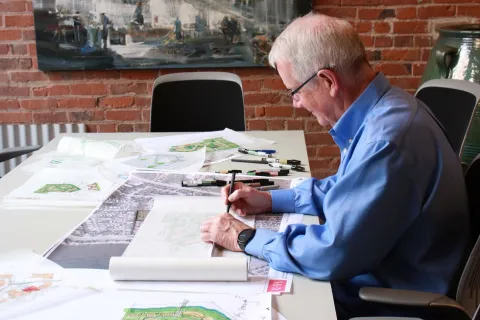UBC Alum Bryce Rositch Donates $2.5M to UBC’s Architectural Future

When considering a building, we tend to focus on the spectacular rooms inside or the vibrant façade outside. But architect Bryce Rositch believes the “spaces in-between” truly bring a building to life.
He’s referring to overlooked functional areas like circulation areas and hallways—spaces that connect us to other living spaces, creating the movement and flow of a well-thought-out design, spaces that invite people in.
Given this view of architecture, it may come as no surprise that Rositch, a double UBC Alumnus and the founding principal of Rositch Hempill Architects—now RH Architects—has donated $2.5M to the Applied One capital campaign. Far more than a new building for UBC Faculty of Applied Science, Applied One will be a dynamic educational and research environment that, in a sense, promotes “in-between thinking” as well.
How? Despite a tendency for architects to work closely with engineers, planners and other applied fields outside the university system, most architecture schools (and UBC’s School of Architecture and Landscape Architecture is no exception) don’t offer these critical interactions in the classroom or studio.
Yet it’s in the spaces between academic fields—engineering and architecture, say—where new understanding and innovations often arise.
“Applied One is an opportunity for architecture students to understand what engineers and planners are doing,” says Rositch, a former President of the Architectural Institute of British Columbia and member of the UBC Board of Governors. “They’ll understand how to interact and interrelate with them, and how we can work with and help each other.”
This gift should resonate with anyone who recognizes that tomorrow’s challenges require places that are more diverse, collaborative and interdependent than those of any one profession.
The architectural process, Rositch explains, involves consultation with a dizzying number of disciplines: structural engineers, geotechnical engineers, urban planners, surveyors, interior designers, sustainable design experts, among so many others. This occupational reality, however, isn’t reflected in the way architecture schools educate their future professionals.
Applied One, Rositch believes, will change that.
A double UBC alumni originally from Kamloops, Rositch was the first member of his family of five to attend university. “I had to pay my way through two degrees, both at UBC,” he says. “And since then architecture has been really good to me. While it does have pressures and stresses, I love the profession and feel a responsibility to give back to it.”
Rositch, as founder and principal of RH Architects, has designed such master neighbourhoods as Coquitlam’s Windsor Gate and buildings as Vancouver’s King Edward Village. He’s also a founding board member of the Urbanarium, a talk series that provides Metro Vancouver, as the website states, “with a platform for discussing advanced ideas and issues about the planning and design of urban systems and futures.”
The Applied One building will likely feature public talk and lecture spaces to promote ideas and debates not unlike those of the Urbanarium. Imagine studios, hangars and other flex spaces, too, in which students learn to view and practice the tools of design, technology and policy in a more integrated fashion.
“Bryce has demonstrated timely leadership with his support for Applied One,” says SALA Director Ron Kellett. “This gift should resonate with anyone who recognizes that tomorrow’s challenges require places that are more diverse, collaborative and interdependent than those of any one profession.”
Blueprint: Vancouver
Consider contemporary issues like the climate emergency and inequity, both complex entangled problems that no one discipline could address alone. Except UBC still educates planners, engineers and architects in not only separate studios and labs, but in buildings spread over one square kilometre of the Vancouver campus.
Arguably, this physical divide at UBC continues to reinforce the educational divide between disciplines.
“The more we architects know about what structural engineers and urban planners do,” Rositch says, “the more we can rely on them, and they on us. The more successful, too, will be our building projects.”
Rositch points to highly integrated buildings in Europe, zoning bylaws that allow for the construction of highly stratified buildings with floors dedicated to different uses. The bottom floor may feature a baguette shop; the second, offices; the third, clothing production; and the fourth, residences. In communities like Wesbrook at UBC, Vancouver has already taken this vertically integrated approach.
“Vancouver is very progressive in our land use and the different types of housing we provide,” Rositch says. “The city also considers sustainability, greenery, lifestyle and opportunities for people to gather.”
For this reason, he believes, UBC Vancouver is the perfect place to launch an integrated approach to architectural education. “I hesitate to use the phrase ‘world leader,’” he says, “but we can offer solutions and guidance to other cities in the world.”
But before the $300M Applied One can achieve any of this, the capital campaign must raise donations. Rositch mentions that his architecture class of 1976 had 72 enrolled in first year, many of whom are now the principals of firms.
“They've done really well, as I have,” he says. “I hope all of us who have benefited from this profession would want to step up and invest in this future. And now's a good time to do that.
“It’s time for a new architecture building at UBC.”


